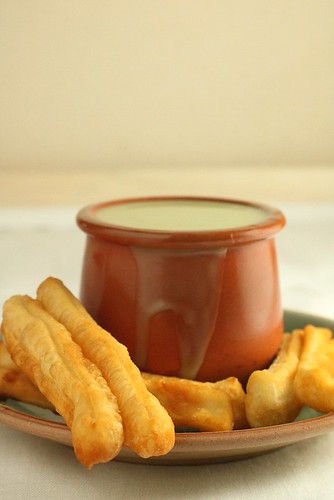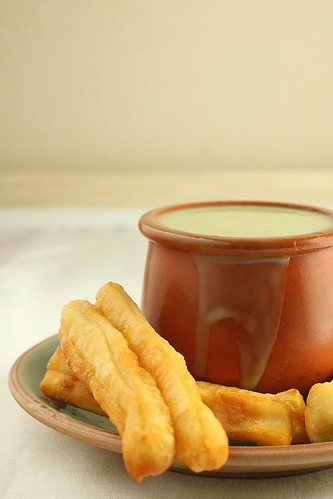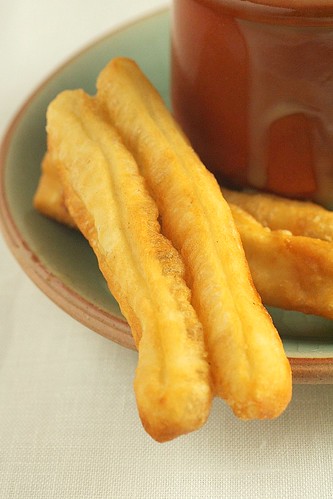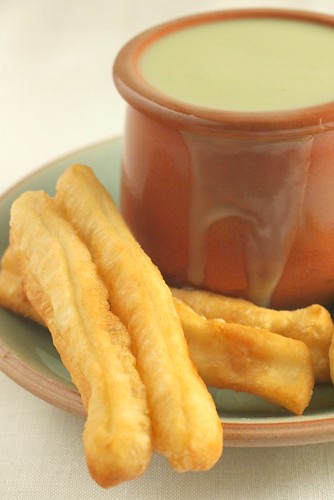


We have a saying in Chinese that goes like this... 吃饱饭没事做. Literal translation of that is 'Having nothing better to do after being fed'. The phrase is normally used to describe people who choose to engage in frivolous, meaningless deeds. As I kneaded the dough with perspiration beads forming on my fore head, that phrase resonated incessantly in my head.
Youtiao/ Yau Char Kuai are humble street food that I can find in many parts of Asia. In China/ Taiwan, this deep fried bread dough is taken for breakfast with soya bean milk. We also dip this into savoury porridge for breakfast or lunch. In Singapore/ Malaysia, we mix this with sweet prawn paste and vegetables in a local salad dish known as Rojak. And yes, we have also acquired the taste of dipping these in coffee.On the streets of Thailand, they have started serving this with pandan coconut custard. Quite simply, to me, the Yau Char Kuai/ Youtiao is the Baguette of the East.
However, nobody ever bothers to make this at home. When I was younger, we used to buy this for 30cents. Now with inflation and affluence, it has gone up to between 50cents and a dollar. Like what L had sensibly put it, you can get everything for a couple of bucks without any hassle.

When I first saw this recipe at Ellie's Almost Bourdain, I had wanted to make it. I was originally only curious about the custard because I had eaten it on crusty toasted bread in Bangkok and it was delicious. 2 weeks ago, when L and I were in Bangkok,we spotted these finger sized Youtiao and I knew I had to try them. L's verdict was that the longer versions tasted better as they are softer and more fluffy in the inside. The shorter ones which are stretched less, were denser. Then last week I came across an article in the papers about David Thompson whose cookbook ' Thai Street Food' was the original source of this recipe. David Thompson, an Australian chef who had won a Michelin star for his Thai restaurant, Nahm, in London, recently created some controversy when he opened a branch in Bangkok and caused general outrage after he was quoted as saying he was on a mission to revive Thai cuisine.
Words spoken out of ill-judgement, I felt. If anything, Thais are gentle but very nationalistic people. I can still recall how my Thai classmate in primary school used to tell me proudly that Thailand is the only SE Asian country that has never been conquered by foreigners.
Anyway, when I saw David Thompson's article, I immediately thought of this street dish again. Maybe it is a calling or whatever you call it, so as '吃饱饭没事做' as it may be, I still decided to make this.
I do recall seeing how the street vendors would pull and stretch the dough, cut them into thin strips, stack them together and press a chopstick over them. However, doing this at home is quite a feat. Awkward with the wet dough, I sprinkled flour on my pastry board and tried to roll the dough out as consistently as I could. Boy, did my kitchen look like a flour speckled war zone after the exercise. It took a while for me to get a feel for the dough. About half of my fried Youtiao looked really ugly, short and stubby with some looking more like fried dough squares. I got the hang of it after a while but working by yourself is tricky. I now know why there was always 2 people working at the stall, one would monitor the oil temperature and tend to the frying dough while the other concentrated on pulling and cutting the dough.
So would I do this again? Hmmm.... not in a heartbeat but I believe I would.

Recipe (As seen at Ellie's Almost Bourdain)
Please refer here for Pandan Coconut Custard
Bread Dough
Ingredients
About 1/2 tsp salt
1 tbsp white sugar
1/2 tsp bicarbonate of ammonia (baking ammonia) or 1 tsp bicarbonate of soda (baking soda) (* See note)
2 cups sieve plain (all-purpose) flour - more as needed
about 2 tsp vegetable oil
plenty of vegetable oil, for deep-frying
Method
1.In a large bowl, mix the salt, sugar and bicarbonate with 1 cup of water, stirring until dissolved. Pour the flour into a large bowl. Make a well in the centre, then add a few tbsps of the prepared water. Work to make a loose, dry crumb then gradually incorporate the remainder of the water as well as the oil, kneading well after each addition. While kneading, occasionally gather the dough into a ball, pick it up and slap it several times, to stretch the gluten. When all is added, continue to knead and slap for at least 5 minutes - longer is better - to arrive at a silken, smooth, soft yet quite wet dough. The dough must be quite wet - if it's too dry, this will inhibit the puffing of the bread as it cooks.
2.Cover and leave to prove and ferment slightly in a warm, airy place for 6-8 hours or longer, until the dough has almost doubled in size and slowly springs back when pressed.
3.On the streets, the dough is patted and knocked back then slowly and gently stretched into long rectangular strips about 20 cm x 5 cm x 5 mm (8 in x 2 in x 3/4 in). Home cooks might prefer to roll the dough into the required shape. Make sure the surface and the rolling pin are dusted with plenty of flour to help prevent the dough from sticking. Leave to rest and prove for about 10 minutes, covered with a slightly damp cloth.
4.Now cut into smaller strips, each piece about 5 cm x 2 cm (2 in x 1 in). Brush the centre of a piece with a little water and top with another piece, pressing the middle sections lightly together. Repeat with the remaining strips. Some cooks use a skewer dusted with flour to do this, lifting one piece of the dough and pressing it against the other piece in the middle to secure the pair.
5.Pour the deep-frying oil into a large, stable wok or a wide heavy-based pan until it is about two-thirds full. Heat the oil over a medium-high flame until a cooking thermometer registers 180-190C (350-375F). Alternatively, test the temperature of the oil by dropping a cube of bread - it will brown in 10-15 seconds if the oil is hot enough.
6.Deep-fry the bread 4 or 5 pieces at a time until puffed, floating and golden. Turn each piece constantly during the deep-frying, to ensure that the dough puffs up then cooks and colours evenly. Experienced street cooks will deep-fry as many as 20 in a batch, but I have found that 4 or 5 at a time is enough to handle. Most cooks in Thailand will use a pair of large, long chopsticks to turn the pieces of bread - you can too, or a long-handled pair of tongs will do the trick. As each batch is cooked, lift out with chopsticks or tongs and drain on paper towel. Use a fine strainer to scoop out any scraps, which would taint the oil, and repeat until all of the shaped and cut dough is used.
7.Serve warm with a bowl of sugar or some dipping custard and a newspaper, and pepper with some gossip.

This looks fantastic! Im making. Im surprised that there is no yeast in teh recipe. N yet it doubles in bulk? wow. Im definitely trying..thanks to you n Ellie :)
ReplyDeleteZurin, yes, I was surprised too that it does not have yeast and uses only plain flour. I did leave the dough overnight though- so that gave it more time to proof.
ReplyDeleteI love the saying "吃饱饭没事做." a lot of my baking are done because of that! lol. Your bread sticks look fantastic!! Thanks for the shout out.
ReplyDeleteMmm these remind me of churros, which are kind of like a Mexican version covered in cinnamon sugar. good stuff. They look delicious although I'm sorry they were such a pain to make!
ReplyDeleteThat's so refreshing"Not in a heartbeat but I would:)"
ReplyDeleteGreat lighting here too.. You girls and your great photos!!
Wow, that looks delicious! And beautiful too.
ReplyDeleteHaha... before I read your post, I was also thinking this too... Shirley, you 吃饱饭没事做 ah! Of all the recipes why choose such a difficult one! Anyway well done!Your YCK really looks like stall made. I love dipping it in Kopi-o.
ReplyDeleteHaha..even if I were to 吃饱饭没事做, I wouldn't make this! The kneading part sounds like a PITA. But you did a great job, looks store-bought!
ReplyDeleteI like those fried sticks with a large glass of soya milk. Yummy!
ReplyDeleteInteresting! They remind me of Spanish churros which I've never had but somehow I can imagine they'd be similar to these?
ReplyDeleteThis looks great! I love eating it with congee...!
ReplyDeleteLike some who already commented, even if I were to 吃饱饭没事做, I would also not make this (as if my "genre" of cooking and food is not obvious enough). Plus, I am also not a big fan of You Tiao ever since I came to know abt ammonia or ammonia derivative being used some You Tiao stalls.
ReplyDeleteLooks really good Shirley!! You know I was contemplating between you tiao or ham chin peng. :) no lah, this is not after meal nothing to do, this is call a baking/ cooking itch! Btw, the you tiao looked so nicely fried and even colored! Nice!!
ReplyDeleteHaha! I think you just have the curiosity and eagerness to learn about the many things that others are taking for granted, e.g. these 油炸鬼. I do take them but never quite intend to make them at home because I try not to deep-fry as much as possible. I respect you for that!
ReplyDeleteYa know what, I do love eating mine with soy milk after being introduced to this way of serving years ago by my mom. Have never thought of serving it with kaya though. That's a good idea!
Wow! This looks so good!! I've always wanted to make this, but our wok is so tiny, I'd only be able to make the short version =) I always find things which are cheap and easy to buy really interesting to make as no one would think of making it at home- like noodles and crackers. Unofrtunately, I've never seen these being made- only on television which doesn't really count! I'd love to see these made in front of me one day! Here in Australia, good yau char kuai isn't all that common- most of the ones I've had at restaurants have been served warm =( So making these at home would be a good idea ;P
ReplyDeletebtw, I can read the first two words in the quote! yay! haha.... I'll have to ask my parents about the rest of them :)
@Von- I actually made the short ones too. These are about 5cm long. Glad my post allows you to learn a few more Chinese characters :)
ReplyDeleteWe eat these with porridge or with sweet bean desserts. For both, we cit them up to 1/2 inch thickness and use the much like croutons in a thick soup!
ReplyDeletethis sounds amazing! I can't resist any sort of fried dough!
ReplyDeleteWhen I was at school, I also thought that they had too much self-interest at heart. They were not colonised because they signed a pact with the Japs! Literally letting them cycle through Malaysia to reach us from behind. Better be colonised than to have collaborated, no?
ReplyDeleteNice youtiao, by the way. Craving for some now.
@Beau lotus- now that you've mentioned it I do recall about the pact! I am lucky that I didn't have to live through the Japanese occupation but I think our older generation here emerged a stronger nation.
ReplyDeleteThis looks amazing. Nothing better than the combo of crispy and creamy.
ReplyDeleteYour "Please refer here for Pandan Coconut Custard" doesn't actually link anywhere. Just though you should know. :)
ReplyDeleteTiff, Thanks so much! Just fixed it.
ReplyDeleteFinger sized Youtiao sounds interesting to me cause ours here are usually about a foot long. I think I have tried shorter ones but not necessarily to finger-sized.
ReplyDeleteYours youtiao look great, and I would love to have them for making homemade sticky rice rolls.
That's quite an effort to make YCK!
ReplyDeleteWell done! I love this with kaya.
I am too lazy to make this, just bought some for porridge :)
ReplyDeleteLooks just like shop bought ones!
I only found out abt dipping yau zhar kwai in coconut custard last year from some malay friends. All these while, I dip them in condensed milk. My aunt thought me to dip in black coffee..
ReplyDeleteBut, dipping in bah kut teh soup is best ;)
Ooh I love this especially straight from the wok! In KL we would dip this into hot black kopi-O. I presume the coconut custard is kaya. After reading your method, I think I'll continue buying mine from the stall.
ReplyDeleteShirley, your yau char kuai looks great! I just had it twice last week, I think unless there is baked version, if not chances for me to try this out is low :P.
ReplyDeleteI can never resist a good YCK. One of my favourites.
ReplyDeleteThe "*note" is missing from ur post.
I will make this YCK when I 吃饱饭没事做, hehehe..Lovely pictures as usual!
ReplyDeleteI love youtiao! My favorite is a classice pairing of dipping it in lightly sweetened soymilk but this custard looks like a great choice when in the mood to try something different. Props to you and Ellie for making this at home :).
ReplyDeleteHaha you're hilarious shirley! I can't believe you made you tiao!!! Wow! They look 100% authentic though. Great job!
ReplyDelete